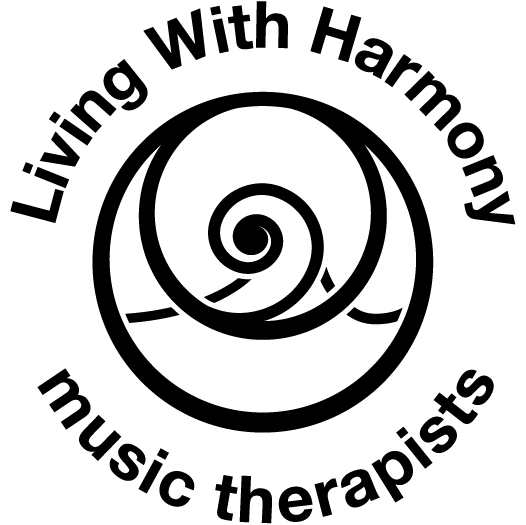Social development and peer interaction are among the goals of Living with Harmony group music therapy. Participants can become involved through improvised music making or known songs which they have chosen. The therapists evolve each musical experience to stimulate satisfying connections and each individual is encouraged to participate to his or her fullest extent. Close teamwork between two therapists stimulates and supports the clients' involvement in order to maximize the social and emotional benefits for each one.
Group Music Therapy Scale
Living with Harmony like to share how we think as practitioners. Our group music therapy scale is part of how we assess and evaluate our practise.
Level 0 – Pre therapy
How It Appears
This looks like an ordinary part of life within what ever setting or context.
The therapists are in role, listening to and attuning to their clients or potential clients and at the same time making the session available. That could look like mirroring posture or movements, responding to rhythms or tones of speech and reflecting the verbal content of the clients expression. The therapists are inviting participation and at the same time manifesting the core aspects of music therapy to support consent and build trust.
Why That is Important
Inviting the client to group music therapy without pressure to attend but also with the experience of being wanted can be the most complex area of the work. This is a 'try out' time for the relationship and because clients can reject and still experience acceptance and containment this builds trust for the future. Modelling listening and attunement is valuable for the person and also for anyone witnessing because it offers listening and accepting as a useful option. It is important to value being with a person as they are. Asking and inviting someone to attend the group is key to the whole process, participants make the group.
Level 1 – Attend the session
How it Appears
When working within a designated therapy space the clients are choosing to be in the room. There may or may not be connections between the participants. The therapist is able to offer a musical context which is containing the group. Any active responses are unconscious/evoked or sensory.
Why That is Important
Being in the therapy space offers an opportunity for further developments and may of itself be a commitment. It is important for the individual and also for the group because it brings validation to the group's existence.
Level 2 – Parallel involvement
How it Appears
Group participants are exploring with instruments, voice/speech or movement. The engagement is still evoked but there is awareness of others also exploring at the same time. The music may be chaotic and is contained by the improvisation of the therapists. The feeling is of being together at a global level.
Why That is Important
Trying out and exploring at a sensory level is useful because it gives confidence to the participant and allows for ownership. It also gives the therapist opportunities to continue to model attunement and active listening. Demonstrating the worth of the clients through responding to their expression increases trust and self esteem.
Level 3 – Peer awareness
How it Appears
Participants are listening to each other evident in their imitating or joining with the musical ideas of other group members. There is active listening in the group and that will appear as responses to pulse, meter, rhythmic patterns, phrase ends and other musical elements in the improvisation.
Why That is Important
Awareness of self and other is a key element in relationship. Being able to hear another in the music means you are able to at least tolerate if not enjoy their ideas and work with them. It is also means that in listening you are able to start predicting what will happen next. These are vital life skills for staying safe in all relationships. Practising listening to others and sharing ideas in group music therapy can be generalised into safer and happier relationships outside the group.
Level 4 – Organisation and control
How it Appears
Participants are initiating independently their own ideas within the whole group music-making. There is variety in the shared music making. Organisation is evident in the differentiation of sound qualities and the interplay of complex elements such as rhythms, melodic lines, dance like movement sequences and songs. The group is developing self-control and regulation. At times there is musical mutuality and individuals are confident and tolerant of each others needs.
Why That is Important
Independent initiation is an indicator of creative potential and developing an intrinsic and creative attitude is central to wellbeing and emotional and mental health. Being responsible for yourself and mindful of others is evidence of both wellbeing and resilience.
Level 5 – Creative expression
How it Appears
The group musical expression values the aesthetic product. The music-making flows and is both inclusive and creatively free. The co-creational element of the session is understood. There is equal value for all participants including the therapists. Participants have ownership of the group and show pleasure in achievements.
Why That is Important
To be creatively free and at the same time valuing others is a strong indicator of mental and emotional wellbeing. It also points to an intrinsic valuing of the self and the ability to take responsibility, joyfully for the act of creation.
N.B. The scale is a guide only. A group may move around the levels in one session or stay in one place for many sessions. Individuals change and this will shift the group. The levels described are points on a continuum. They have helped us in thinking about group music therapy, if they are useful to you please share and enjoy.
With thanks to the Nordoff Robbins scales of assessment and to David Mearns concept in Rodgerian counselling of pre therapy.
This scale was first published as part of Meta Killick's MA on group work with children at Anglia Ruskin University.

